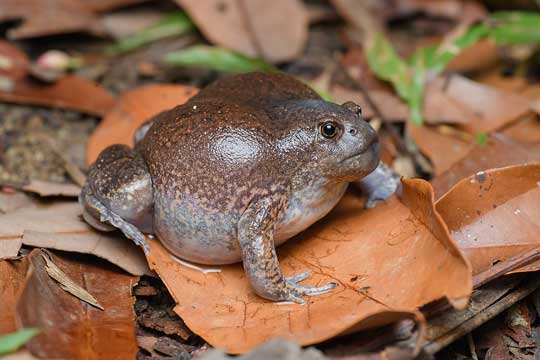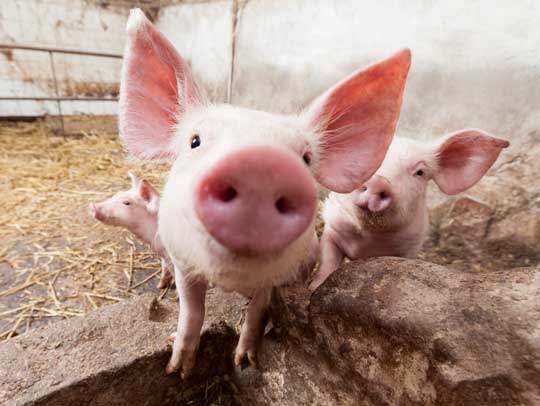|
Did you know that, without bats, there would be no tequila? The lesser long-nosed bat feeds on cactus nectar. These bats fly up to 700 miles (1,126 km) per year as they follow the blooming of cactuses northward from Mexico to the US. At night, the bats fly up to cactus flowers and stick their long tongues in to lap up the yummy nectar. In the process, the bats get pollen stuck to their faces, and then they unwittingly transfer some of that pollen to other flowers. These bats feed on up to a hundred cactus flowers per night.
One of the long-nosed bat's favorite flowers is that of agave, which is used to make tequila. In fact, bats are the primary pollinators of agave. Without bats, agave wouldn't exist. Without agave, tequila wouldn't exist. And wouldn't that be a sorry state of affairs. Below are long-nosed bats at a feeder.
0 Comments
Did you know some frogs and toads inflate with air to protect themselves? The champion of this strategy is the blunt-headed burrowing frog, which is often called the balloon frog. Why would this frog blow itself up into a balloon like this? Three reasons, really, and they all have to do with avoiding being eaten. First, by appearing larger when threatened, the frog has a better chance of scaring off predators (You know how they say to make yourself look bigger if you are ever confronted by a bear or mountain lion? Same concept for the frog). Second, because these frogs spend a lot of time in burrows, they can inflate to wedge themselves in tightly, making it difficult for a predator to pull them out. And third, becoming a big balloon makes it difficult or impossible for a predator, especially a snake, to swallow them.
Unfortunately, the blunt-headed burrowing frog is prized by humans as a tasty meal in its home range of Cambodia, Laos, Myanmar, Thailand, and Vietnam. People catch and eat so many of them that the frog species is now threatened. A popular Thai dish, these frogs are usually eaten barbecued. Yum. Did you know Bigfoot is a protected species in Skamania County, Washington? Yep, I'm talking about Sasquatch, the elusive human-like creature that supposedly roams the remote wilderness of the northwest US. Sorry, believers, but the creature is overwhelmingly considered a myth. On April 1, 1969, Skamania County officials passed Ordinance number 6901, protecting the Bigfoot creature. Although this happened to be on April Fool's Day, it was not a joke.
So, why would a county (actually, there are two counties that have done this) protect a fictional creature? The answer lies within the text of the ordinance: "WHEREAS, there is evidence to indicate the possible existence in Skamania County of a nocturnal primate mammal variously described as an apelike creature or a subspecies of Homo Sapian [sic]; ...and WHEREAS, publicity attendant upon such real or imagined sightings has resulted in an influx of scientific investigators as well as casual hunters, many armed with lethal weapons, and WHEREAS, the absence of specific laws covering the taking of specimens encourages laxity in the use of firearms and other deadly devices and poses a clear and present threat to the safety and wellbeing of persons living or traveling within the boundaries of Skamania County as well as to the creatures themselves, THEREFORE BE IT RESOVLED that any premeditated, willful and wanton slaying of any such creature shall be deemed a felony punishable by..." So, perhaps part of the reason for the ordinance is, if the creature does exist it must surely be an endangered species. However, the main reason is to protect people. Which is a legitimate concern. After all, you don't want hunters out there trying to shoot a human-like creature in an area where numerous humans are wandering around looking for bigfoot. Did you know polar bears have black skin, and their fur isn't really white? Yes, they appear white when you look at them, but the real story is somewhat complex, so let's take a closer look.
First, it's important to understand how we perceive color. A red stop sign appears red because the red paint absorbs all colors (wavelengths) except for red, which is reflected back to your eyes. The paint on a black car absorbs all colors, so no colors are reflected to your eyes. White paint, on the other hand, reflects all colors, and therefore looks white. This, of course, is why you stay cooler wearing white on a summer day, compared to wearing black. Well, beneath a polar bear's thick fur is black skin. This helps the bear absorb sunlight, converting it into body heat. Wait! Doesn't the bear's fur reflect all the sunlight, preventing the black skin from absorbing the light? Here's where things get interesting. A polar bear's fur isn't white at all! Each hair is hollow, and it basically has no pigment, like a miniature version of a transparent plastic straw. When sunlight hits the fur, the light goes through a complex scattering pattern and it hits the bear's black skin, warming the bear. Only a small amount of the light is reflected, and because sunlight is all colors—in other words, white—that's why we perceive polar bears to be white. If it wasn't for this complex scattering phenomenon, the bear's fur would appear transparent, and we would see the black skin when we look at a polar bear. Did you know far more pigs are raised in China than any other country? As of April 2022, China farmers have 450 million pigs. In second place, the entire European Union has 140 million pigs. In third place, the United States has 74 million pigs. In 2022 China is projected to produce 51,000 metric tons of pork.
Why does China raise so many pigs? Well, pigs have played a significant role in the culture (and farming) of China for thousands of years. Initially, wild pigs would forage near human villages, and over a period of 8,000 years, as the human population grew, Chinese people gradually domesticated these pigs. They started putting them into pens near their dwellings, not just for the meat, but also to use them as garbage disposals and fertilizer producers. The people gradually bred them to grow faster and produce larger litters. Europeans found that Chinese pigs were much better than their own pigs, and they bred the two types together, eventually creating most of the modern, high-production breeds that are raised all over the world today. In China, pork is much preferred over beef, as the people consider the pork fat and the color of the meat to be superior. They consider the taste and smell to be sweeter and cleaner. Also, in China, pork has traditionally been served to celebrate culturally-significant events. Chinese farmers are now building multi-level pig-raising facilities, some of which are twelve stories tall. Did you know the loudest land animal is the howler monkey? Trish and I have been lucky enough to see and hear howler monkeys in Belize and in Costa Rica. You can literally hear them several miles away as they call to each other.
Howlers often howl at each other in territory disputes. However, the males also use their raucous howls to attract mates. Perhaps you already know that, but I'm going to tell you a part of the story you may not know... the loudest male howler monkeys have the smallest testicles. Yep, that's right. Louder calls = smaller balls. Studies have revealed that howler monkeys basically have two different types of social structures: 1. Single-male groups in which one male has a harem of a few females. 2. Larger, multi-male groups in which multiple males mate with multiple females. The males in single-male groups have louder calls, yet they have smaller testicles (which produce fewer sperm cells). The males in larger, multi-male groups have softer calls, yet they have larger testicles (more sperm produced). Why? Because males with louder voices are better able to convince females to join their harem... but, on a day-to-day basis they are not competing with other males to produce offspring with those females. Therefore they do not need excessively high sperm production. And males with softer voices are not able to form their own harems, and they must compete with other males to produce offspring with the same group of females, therefore they benefit by having larger testicles that produce more sperm cells. Aren't you glad you asked? Awesome Animal Fact:
Did you know ostriches are capable of killing a lion? Ostriches, the tallest and heaviest living birds in the world, are generally herbivores, although they also eat small animals like lizards and insects. They aren't typically aggressive unless they feel threatened, but they often DO feel threatened, particularly during mating season, nesting season, and when the hatched babies are young. Therefore, they are considered unpredictable and often dangerous. In fact, several people are killed by ostriches every year, and even more are injured. Ostriches are extremely aggressive when they feel threatened, or when their young are threatened. How can they be so dangerous? It's all in those long, muscular legs. Ostriches are capable of impressively powerful forward kicks. They have two toes on each foot, and the longest toe has a formidable claw, which can kill and/or disembowel a human or other large animal. Don't get me wrong... as explained above, ostriches sometimes get the best of predators using their powerful kicks, BUT they're also often killed by predators. Sometimes they can escape simply by running, as these birds can run at up to 43 miles per hour (69 km/hr). Awesome Animal Fact:
Did you know the jewel wasp has a habit of turning cockroaches into zombies? The jewel wasp, which lives in Africa and Asia, has beautiful metallic blue and green colors, but many people find its zombification of cockroaches to be rather macabre. I find it to be totally awesome. So, how exactly does the wasp do this? It all starts with the wasp looking for a host cockroach to lay an egg on. Jewel wasps are specifically adapted to using cockroaches, so no other insect will be suitable. When the wasp comes upon a nice, juicy cockroach, it attacks the much larger insect and injects a neurotoxin. This substance blocks the release of a certain chemical in the cockroach's ganglia (its brain) that normally gives the cockroach the motivation to run away and escape. The neurotoxin kicks in quickly. The roach remains fully functional except that it has lost its free will. For some reason, it follows the wasp wherever the wasp leads it. As you can probably guess, the wasp walks to its nest, and the cockroach follows it there, unable to do otherwise. Once in the nest, the wasp lays a single egg on the roach's body. Then it goes out to collect a bunch of pebbles to build a barrier around the cockroach to protect the egg. After that, it goes out to search for another cockroach to zombify. The egg hatches after two days, and the wasp larva feeds on the cockroach's body. Amazingly, the larva first feeds on all the body parts and fluids that the roach can still stay alive without. Only when all the organs and "blood" (called hemolymph) are gone will the wasp larva consume the roach's nervous system, finally killing it. It's not over yet, though. The wasp larva lines the inside if the cockroach body with an antimicrobial secretion. For the next month, the larva remains inside the hollowed-out body as it transforms into an adult wasp. Finally, the adult wasp bursts out of the "cocoon" (alien-style) and begins the entire life cycle all over again. Below is a jewel wasp attacking a cockroach. |
Stan's Cogitations
Everyone needs a creative outlet. That's why I write. Archives
July 2024
|









 RSS Feed
RSS Feed